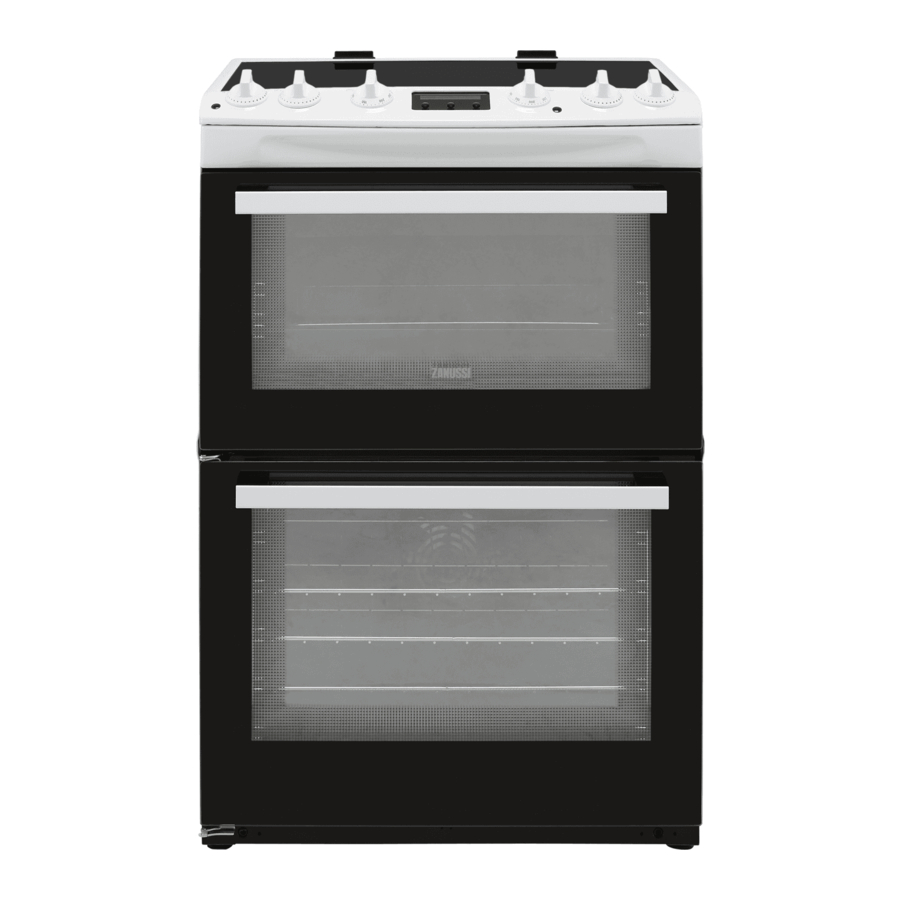
Zanussi ZCI66280WA, ZCI66280BA, ZCI66280XA - Electric Cooker Manual
- User manual (33 pages) ,
- User manual (36 pages)
Advertisement
- 1 INSTALLATION
- 2 PRODUCT DESCRIPTION
- 3 BEFORE FIRST USE
-
4
HOB - DAILY USE
- 4.1 Hob control panel
- 4.2 Heat setting displays
- 4.3 OptiHeat Control (3 step Residual heat indicator)
- 4.4 The heat setting
- 4.5 Automatic Switch Off
- 4.6 Automatic Heat Up
- 4.7 PowerBoost
- 4.8 Timer
- 4.9 Pause
- 4.10 Lock
- 4.11 Child Safety Device
- 4.12 OffSound Control (Deactivation and activation of the sounds)
- 4.13 Hob²Hood
- 4.14 Power management function
- 5 HOB - HINTS AND TIPS
- 6 HOB - CARE AND CLEANING
- 7 OVEN - DAILY USE
- 8 OVEN - CLOCK FUNCTIONS
- 9 OVEN - HINTS AND TIPS
- 10 OVEN - CARE AND CLEANING
- 11 TROUBLESHOOTING
- 12 ENERGY EFFICIENCY
- 13 SAFETY INFORMATION
- 14 SAFETY INSTRUCTIONS
- 15 Documents / Resources

INSTALLATION
Refer to Safety chapters.
Technical data
| Dimensions | |
| Height | 894 - 912 mm |
| Width | 600 mm |
| Depth | 600 mm |
Location of the appliance
You can install your freestanding appliance with cabinets on one or two sides and in the corner.
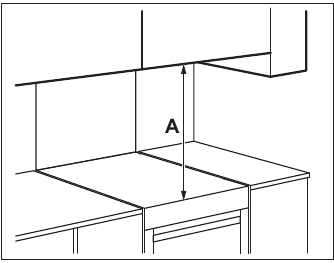
Minimum distances
| Dimension | mm |
| A | 650 |
Levelling of the appliance
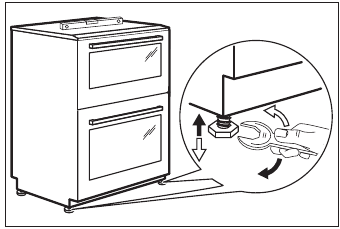
Use small feet on the bottom of appliance to set the appliance top surface level with other surfaces.
Electrical installation
The manufacturer is not responsible if you do not follow the safety precautions from Safety chapters.
This appliance is supplied without a main plug or a main cable.
Applicable types of cables for different phases:
| Phase | Min. size cable |
| 1 | 3x6.0 mm² |
| 3 with neutral | 5x1.5 mm² |
The power cable must not touch the part of the appliance shaded in the illustration.
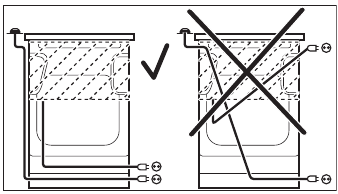
Covering terminal board
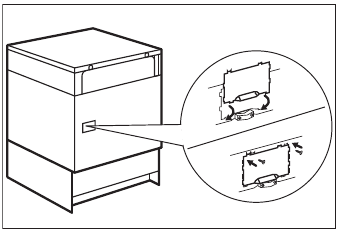
- The recommended cross-section area is six square millimetres (6 mm²).
- When you refit the mains terminal cover, make sure that the lower tabs are located inside the bottom edge of the aperture, before you fix the two screws into the top edge of the mains terminal cover.
- Make sure that the cover is securely fastened.

Terminal board

Make sure that the links are fitted as shown.
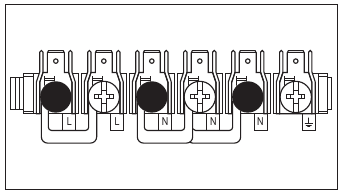
PRODUCT DESCRIPTION
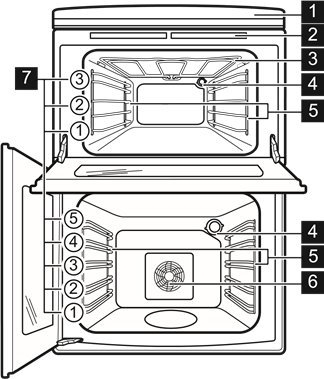
- Control panel and hob
- Air vents for the cooling fan
- Heating element
- Lamp
- Shelf support, removable
- Fan
- Shelf positions
Hob overview
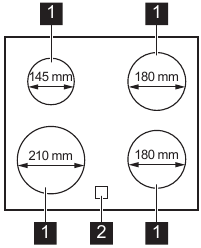
- Induction cooking zone
- Control Panel
Cooker control panel
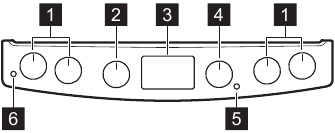
- Knobs for the hob
- Knob for the top oven functions
- Display
- Knob for the main oven functions
- Temperature indicator / symbol for the main oven
- Temperature indicator / symbol for the top oven
Accessories
- Wire shelf
For cookware, cake tins, roasts. - Grill- / Roasting pan
To bake and roast or as pan to collect fat. - Trivet
For roasting and grilling.

BEFORE FIRST USE
Refer to Safety chapters
Initial Cleaning
Remove all accessories and removable shelf supports from the appliance.

Clean the appliance and the accessories before first use.
Put the accessories and the removable shelf supports back to their initial position.
Using the sensor fields
To activate the function press and hold the selected symbol on the display for at least 1 second.
Setting and changing the time
You must set the time before you operate the oven.

When you connect the appliance to the electrical supply or after a power cut, ![]() flashes.
flashes.
Press the  or
or  to set the correct time.
to set the correct time.
After approximately 5 seconds, the flashing stops and the display shows the time of day.
To change the time, press ![]() again and again until
again and again until ![]() starts to flash.
starts to flash.

Preheating
Preheat the empty appliance before first use.

- Set the maximum temperature.
- Let the appliance operate for 1 hour.
- Set the function
![]() .
. - Let the appliance operate for 15 minutes. Accessories can become hotter than usual.
The appliance can emit an odour and smoke. This is normal. Make sure that the airflow is sufficient.
HOB - DAILY USE
Refer to Safety chapters.
Hob control panel
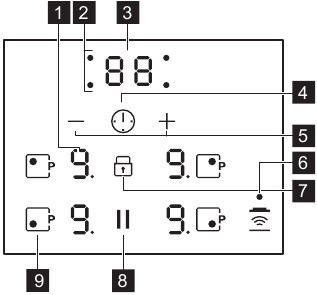
Use the sensor fields to operate the appliance. The displays, indicators and sounds tell which functions operate.
| Sensor field | Function | Comment | |
| 1 | - | Heat setting display | To show the heat setting. |
| 2 | - | Timer indicators of cooking zones | To show for which zone you set the time. |
| 3 | - | Timer display | To show the time in minutes. |
| 4 |  | - | To select the cooking zone. |
| 5 |  | - | To increase or decrease the time. |
| 6 |  | Hob²Hood | To activate and deactivate the manual mode of the function. |
| 7 |  | Lock / Child Safety Device | To lock / unlock the control panel. |
| 8 |  | Pause | To activate and deactivate the function. |
| 9 |  | PowerBoost | To activate and deactivate the function. |
Heat setting displays
| Display | Description |
 | The cooking zone is deactivated. |
 | The cooking zone operates. The dot means a change by half of a heating level. |
 | Pause operates. |
 | Automatic Heat Up operates. |
 | PowerBoost operates. |
 + digit + digit | There is a malfunction. |
 | OptiHeat Control (3 step Residual heat indicator): continue cooking / keep warm / residual heat. |
 | Lock / Child Safety Device operates. |
 | Incorrect or too small cookware or no cookware on the cooking zone. |
 | Automatic Switch Off operates. |
OptiHeat Control (3 step Residual heat indicator)
 As long as the indicator is visible, there is a risk of burns from residual heat.
As long as the indicator is visible, there is a risk of burns from residual heat.
The induction cooking zones produce the heat necessary for the cooking process directly in the bottom of the cookware. The glass ceramic is heated by the heat of the cookware.
The indicators appear when a cooking zone is hot. They show the level of the residual heat for the cooking zones you are currently using:
 - continue cooking,
- continue cooking,
 - keep warm,
- keep warm,
 - residual heat.
- residual heat.
The indicator may also appear:
- for the neighbouring cooking zones even if you are not using them,
- when hot cookware is placed on cold cooking zone,
- when the hob is deactivated but the cooking zone is still hot.
The indicator disappears when the cooking zone has cooled down.
The heat setting
Turn the knob for the heating functions to select a heating function. To deactivate it turn the knob to the off position ![]() .
.
Automatic Switch Off
The function deactivates the hob automatically if:
- all cooking zones are deactivated,
- you do not set the heat setting after you activate the hob,
- you spill something or put something on the control panel for more than 10 seconds (a pan, a cloth, etc.). An acoustic signal sounds and the hob deactivates. Remove the object or clean the control panel.
- the hob gets too hot (e.g. when a saucepan boils dry). Let the cooking zone cool down before you use the hob again.
- you use incorrect cookware. The symbol
![]() comes on and the cooking zone deactivates automatically after 2 minutes.
comes on and the cooking zone deactivates automatically after 2 minutes. - you do not deactivate a cooking zone or change the heat setting. After some time
![]() comes on and the hob deactivates.
comes on and the hob deactivates.
The relation between the heat setting and the time after which the hob deactivates:
| Heat setting | The hob deactivates after |
 , 1 - 2 , 1 - 2 | 6 hours |
| 3 - 4 | 5 hours |
| 5 | 4 hours |
| 6 - 9 | 1.5 hour |
Automatic Heat Up
If you activate this function you can get a necessary heat setting faster. The function sets the highest heat setting for some time and then decreases to the correct heat setting.

To activate the function for a cooking zone: turn the knob for a cooking zone to the ![]() position.
position. ![]() shows on the display.
shows on the display.
Immediately set the correct heat setting.
To deactivate the function: turn the knob to the off position.
PowerBoost
This function makes more power available to the induction cooking zones. The function can be activated for the induction cooking zone only for a limited period of time. After this time the induction cooking zone automatically sets back to the highest heat setting.
To activate the function for a cooking zone: touch  comes on.
comes on.
To deactivate the function: change the heat setting.
Timer
Count Down Timer
You can use this function to set how long the cooking zone should operate for a single cooking session.
First set the heat setting for the cooking zone then set the function.
To set the cooking zone: touch ![]() again and again until the indicator of a necessary cooking zone comes on.
again and again until the indicator of a necessary cooking zone comes on.
To activate the function: touch ![]() of the timer to set the time (00 - 99 minutes). When the indicator of the cooking zone starts to flash slowly the time counts down.
of the timer to set the time (00 - 99 minutes). When the indicator of the cooking zone starts to flash slowly the time counts down.
To see the remaining time: set the cooking zone with ![]() . The indicator of the cooking zone starts to flash quickly. The display shows the remaining time.
. The indicator of the cooking zone starts to flash quickly. The display shows the remaining time.
To change the time: set the cooking zone with ![]() . Touch
. Touch  or
or  .
.
To deactivate the function: set the cooking zone with ![]() and touch
and touch  . The remaining time counts back to 00. The indicator of the cooking zone goes out.
. The remaining time counts back to 00. The indicator of the cooking zone goes out.

To stop the sound: touch ![]() .
.
CountUp Timer
You can use this function to monitor how long the cooking zone operates.
To set the cooking zone: touch ![]() again and again until the indicator of a necessary cooking zone comes on.
again and again until the indicator of a necessary cooking zone comes on.
To activate the function: touch  of the timer.
of the timer.  comes on. When the indicator of the cooking zone starts to flash slowly the time counts up. The display switches between
comes on. When the indicator of the cooking zone starts to flash slowly the time counts up. The display switches between  and counted time (minutes).
and counted time (minutes).
To see how long the cooking zone operates: set the cooking zone with ![]() . The indicator of the cooking zone starts to flash quickly. The display shows how long the zone operates.
. The indicator of the cooking zone starts to flash quickly. The display shows how long the zone operates.
To deactivate the function: set the cooking zone with ![]() and touch
and touch  or
or  . The indicator of the cooking zone goes out.
. The indicator of the cooking zone goes out.
Minute Minder
You can use this function as a Minute Minder when the hob is activated and the cooking zones do not operate. The heat setting display shows  .
.
To activate the function: touch ![]() . Touch
. Touch  or
or  of the timer to set the time. Cooking zones display deactivates automatically after 10 seconds. When the time comes to an end, the sound operates and 00 flashes.
of the timer to set the time. Cooking zones display deactivates automatically after 10 seconds. When the time comes to an end, the sound operates and 00 flashes.
To stop the sound: touch ![]() .
.
To deactivate the function: activate for a short time and deactivate left front cooking zone.

Pause
This function sets all operating cooking zones to the lowest heat setting.
The function does not stop the timer functions.
- To activate the function: press
![]() .
.
![]() comes on. The heat setting is lowered to 1.
comes on. The heat setting is lowered to 1. - To deactivate the function: press
![]() . The previous heat setting appears.
. The previous heat setting appears.

Lock
You can lock the sensors on the hob while cooking zones operate.
Set the heat setting first.
To activate the function: touch  .
.  comes on for 4 seconds. The Timer stays on.
comes on for 4 seconds. The Timer stays on.
To deactivate the function: touch  . The previous heat setting comes on.
. The previous heat setting comes on.

Child Safety Device
This function prevents an accidental operation of the hob.
To activate the function: the hob must be deactivated. Touch  for 4 seconds until
for 4 seconds until ![]() flashes. Touch
flashes. Touch  .
.  comes on for 4 seconds.
comes on for 4 seconds.
To deactivate the function: the hob must be deactivated. Touch  for 4 seconds until
for 4 seconds until ![]() flashes. Touch
flashes. Touch  .
.  comes on for 4 seconds.
comes on for 4 seconds.
To override the function for only one cooking time: activate a cooking zone.  comes on. Touch
comes on. Touch ![]() for 4 seconds until
for 4 seconds until  comes on for all zones. Set the heat setting in 4 seconds. You can operate the hob. When you deactivate the appliance the function operates again.
comes on for all zones. Set the heat setting in 4 seconds. You can operate the hob. When you deactivate the appliance the function operates again.
OffSound Control (Deactivation and activation of the sounds)
Deactivate the hob. Touch  for 3 seconds. Touch
for 3 seconds. Touch  for 3 seconds.
for 3 seconds.  or
or  comes on.
comes on.
Touch  of the timer to choose one of the following:
of the timer to choose one of the following:
![]() - the sounds are off
- the sounds are off![]() - the sounds are on.
- the sounds are on.
To confirm your selection wait until the hob deactivates automatically.
When the function is set to  you can hear the sounds only when:
you can hear the sounds only when:
- Minute Minder comes down
- Count Down Timer comes down
- you put something on the control panel.
Hob²Hood
It is an advanced automatic function which connects the hob to a special hood. Both the hob and the hood have an infrared signal communicator. Speed of the fan is defined automatically on basis of mode setting and temperature of the hottest cookware on the hob. You can also operate the fan from the hob manually.

Operating the function automatically
To operate the function automatically set the automatic mode to H1 – H6. The hob is originally set to H5. The hood reacts whenever you operate the hob. The hob recognizes temperature of the cookware automatically and adjusts the speed of the fan.
Automatic modes
| Automatic light | Boiling1) | Frying2) | |
| Mode H0 | Off | Off | Off |
| Mode H1 | On | Off | Off |
| Mode H2 3) | On | Fan speed 1 | Fan speed 1 |
| Mode H3 | On | Off | Fan speed 1 |
| Mode H4 | On | Fan speed 1 | Fan speed 1 |
| Mode H5 | On | Fan speed 1 | Fan speed 2 |
| Mode H6 | On | Fan speed 2 | Fan speed 3 |
1) The hob detects the boiling process and activates fan speed in accordance with automatic mode.
2) The hob detects the frying process and activates fan speed in accordance with automatic mode.
3) This mode activates the fan and the light and does not rely on the temperature.
Changing the automatic mode
- Deactivate the appliance.
- Press
![]() until you hear a beep and keep it pressed until you hear the second beep.
until you hear a beep and keep it pressed until you hear the second beep. - Press
![]() for 3 seconds until
for 3 seconds until ![]() or
or ![]() comes on.
comes on. - Press
![]() until H and a digit (0 - 6) comes on. H5 is the default setting.
until H and a digit (0 - 6) comes on. H5 is the default setting. - Press
![]() of the Timer to select the desired mode (H0 - H6). The chosen mode activates automatically after 10 seconds.
of the Timer to select the desired mode (H0 - H6). The chosen mode activates automatically after 10 seconds.


Operating the fan speed manually
You can also operate the function manually.
To do that touch  when the hob is active. This deactivates automatic operation of the function and allows you to change the fan speed manually. When you press
when the hob is active. This deactivates automatic operation of the function and allows you to change the fan speed manually. When you press  you raise the fan speed by one. When you reach an intensive level and press
you raise the fan speed by one. When you reach an intensive level and press  again you will set fan speed to 0 which deactivates the hood fan. To start the fan again with fan speed 1 touch
again you will set fan speed to 0 which deactivates the hood fan. To start the fan again with fan speed 1 touch  .
.

Activating the light
You can set the hob to activate the light automatically whenever you activate the hob. To do so set the automatic mode to H1 – H6.

Power management function
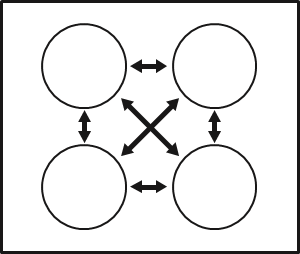
- All cooking zones are connected. See the illustration.
- The hob and both ovens are connected to one phase.
- The phase has a maximum electricity load.
- The function divides the power in the appliance. The oven is more important than the hob.
- The function activates when the total electricity load in the appliance is exceeded.
- The function reduces the power of other cooking zones to prevent a circuit overload.
- The heat setting display of the reduced zones changes between two levels.
- Power limit for all zones is the difference between maximum power allowed for appliance and the power consumption of ovens.
HOB - HINTS AND TIPS

Refer to Safety chapters.
Cookware


Cookware material
- correct: cast iron, steel, enamelled steel, stainless steel, multi-layer bottom (with a correct marking from a manufacturer).
- not correct: aluminium, copper, brass, glass, ceramic, porcelain.
- recommended: aluminium, copper
- not recommended: stainless steel, cast iron, glass
Cookware is suitable for an induction hob if
- water boils very quickly on a zone set to the highest heat setting.
- a magnet pulls on to the bottom of the cookware.

Ensure pan bases are clean and dry before placing on the hob surface
Cookware dimensions
Induction cooking zones adapt to the dimension of the bottom of the cookware automatically.
The cooking zone efficiency is related to the diameter of the cookware. The cookware with a diameter smaller than the minimum receives only a part of the power generated by the cooking zone.
Minimum cookware diameter
| Cooking zone | Cookware diameter (mm) | Power (W) |
| Left rear | 125 - 140 | 1400/2500 |
| Right rear | 145 - 180 | 1800/2800 |
| Right front | 145 - 180 | 1800/2800 |
| Left front | 180 - 210 | 2300/3600 |
Noises during operation
If you can hear:
- crack noise: cookware is made of different materials (a sandwich construction).
- whistle sound: you use a cooking zone with a high power level and the cookware is made of different materials (a sandwich construction).
- humming: you use a high power level.
- clicking: electric switching occurs.
- hissing, buzzing: the fan operates.
The noises are normal and do not indicate any malfunction.
Öko Timer (Eco Timer)
To save energy, the heater of the cooking zone deactivates before the count down timer sounds. The difference in the operation time depends on the heat setting level and the length of the cooking operation.
Simplified cooking guide
The correlation between the heat setting of a zone and its consumption of power is not linear. When you increase the heat setting, it is not proportional to the increase of the consumption of power. It means that a cooking zone with the medium heat setting uses less than a half of its power.

| Heat setting | Use to: | Time (min) | Hints |
 - 1 - 1 | Keep cooked food warm. | as necessary | Put a lid on the cookware. |
| 1 - 2. | Hollandaise sauce; melt: butter, chocolate, gelatine. | 5 - 25 | Mix from time to time. |
| 2. | Solidify: fluffy omelettes, baked eggs. | 10 - 40 | Cook with a lid on. |
| 2. - 3. | Simmer rice and milk-based dishes, heat up ready-cooked meals. | 25 - 50 | Add at least twice as much liquid as rice, mix milk dishes halfway through the procedure. |
| 3. - 4. | Stew vegetables, fish, meat. | 20 - 45 | Add a few tablespoons of water. Check the water amount during the process. |
| 4. - 5. | Steam potatoes and other vegetables. | 20 - 60 | Cover the bottom of the pot with 1-2 cm of water. Check the water level during the process. Keep the lid on the pot. |
| 4. - 5. | Cook larger quantities of food, stews and soups. | 60 - 150 | Up to 3 l of liquid plus ingredients. |
| 5. - 7 | Gentle fry: escalope, veal cordon bleu, cutlets, rissoles, sausages, liver, roux, eggs, pancakes, doughnuts. | as necessary | Turn over when needed |
| 7 - 8 | Heavy fry, hash browns, loin steaks, steaks. | 5 - 15 | Turn over when needed. |
| 9 | Boil water, cook pasta, sear meat (goulash, pot roast), deep-fry chips. | ||
 | Boil large quantities of water. PowerBoost is activated. | ||
HOB - CARE AND CLEANING
Refer to Safety chapters
General information
- Clean the hob after each use.
- Always use cookware with a clean base.
- Scratches or dark stains on the surface have no effect on how the hob operates.
- Use a special cleaning agent suitable for the surface of the hob.
- Always use a scraper recommended for hobs with a glass surface. Use the scraper only as an additional tool for cleaning the glass after the standard cleaning procedure.
Do not use knives or any other sharp, metal tools to clean the glass surface
Cleaning the hob
- Remove immediately: melted plastic, plastic foil, salt, sugar and food with sugar, otherwise, the dirt can cause damage to the hob. Take care to avoid burns. Use a special hob scraper on the glass surface at an acute angle and move the blade on the surface.
- Remove when the hob is sufficiently cool: limescale rings, water rings, fat stains, shiny metallic discoloration. Clean the hob with a moist cloth and a nonabrasive detergent. After cleaning, wipe the hob dry with a soft cloth.
- Remove shiny metallic discoloration: use a solution of water with vinegar and clean the glass surface with a cloth.
OVEN - DAILY USE
Refer to Safety chapters.
Top oven functions
| Symbol | Oven function | Application |
 | Off position | The oven is off. |
 | Oven Lamp | To turn on the lamp without a cooking function. |
| 100 - 250 | Conventional Cooking | To bake and roast food on one shelf position. |
 | Dual Circuit Grill | To grill flat food in medium quantities in the middle of the shelf. To make toasts. |
 | Full Grill | To grill flat food and to toast bread. |
Main oven functions

Do not pour any liquids into the cavity embossment before and during the cooking process. There is a risk of damage.
| Symbol | Oven function | Application |
 | Off position | The oven is off. |
 | Oven Lamp | To turn on the lamp without a cooking function. |
 | Defrost | To defrost food (vegetables and fruit). The defrosting time de‐ pends on the amount and size of the frozen food. |
| 100 - 250 | Thermaflow® | To bake on up to three shelf positions at the same time and to dry food. |
Activating and deactivating the top / main oven

- The indicator comes on when the oven heats up.
- The lamp comes on when the oven operates.
- The symbol shows whether the knob controls one of the cooking zones, the oven functions or the temperature.
- Turn the knob for the top / main oven functions to select an oven function.
- To deactivate the oven turn the knob for the top / main oven functions to the off position.
Cooling fan
When the oven operates, the cooling fan turns on automatically to keep the surfaces of the oven cool. If you turn off the oven, the cooling fan continues to operate until the oven cools down.
Inserting the oven accessories
- Deep pan:
Push the deep pan between the guide bars of the shelf support.
![Zanussi - ZCI66280WA - Inserting the oven accessories - Deep pan Inserting the oven accessories - Deep pan]()
- Wire shelf:
Push the shelf between the guide bars of the shelf support.
![Zanussi - ZCI66280WA - Inserting the oven accessories - Wire shelf Inserting the oven accessories - Wire shelf]()

- All accessories have small indentations at the top of the right and left side to increase safety. The indentations are also anti-tip devices.
- The high rim around the shelf is a device which prevents cookware from slipping.
Trivet and Grill- / Roasting pan
You can use the trivet to roast larger pieces of meat or poultry on one shelf position.
- Put the trivet into the deep pan so that the supports of the wire shelf point up.
![Zanussi - ZCI66280WA - Trivet and Grill- / Roasting pan - Step 1 Trivet and Grill- / Roasting pan - Step 1]()
- Put the deep pan into the oven on the necessary shelf position.
You can use the trivet to grill flat dishes in large quantities and to toast.
- Put the trivet into the deep pan so that the supports of the wire shelf point down.
![Zanussi - ZCI66280WA - Trivet and Grill- / Roasting pan - Step 2 Trivet and Grill- / Roasting pan - Step 2]()
- Put the deep pan into the oven on the necessary shelf position.
OVEN - CLOCK FUNCTIONS
Display

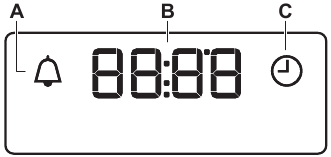
- Minute minder indicator
- Time display
- Time of day indicator
Buttons
| Button | Function | Description |
 | MINUS | To set the time. |
 | CLOCK | To set a clock function. |
 | PLUS | To set the time. |
Setting the MINUTE MINDER
- Press
![]() again and again until
again and again until ![]() starts to flash.
starts to flash. - Press
![]() or
or ![]() to set the necessary time.
to set the necessary time.
The Minute Minder starts automatically after 5 seconds.
- When the set time ends, an acoustic signal sounds. Press any button to stop the acoustic signal.
- Turn the knob for the oven functions to the off position.
Cancelling the clock functions
- Press
![]() the again and again until the necessary function indicator starts to flash.
the again and again until the necessary function indicator starts to flash. - Press and hold
![]() .
.
The clock function goes out after some seconds.
OVEN - HINTS AND TIPS
Refer to Safety chapters.

Top oven
The top oven is smaller than the main oven. It has 3 shelf positions. Use it to cook smaller quantities of food. It is especially good for baking fruitcakes, cookies, savoury flans or quiche.
Main oven
The main oven is particularly suitable for cooking larger quantities of food.
Baking
For the first baking, use the lower temperature.
You can extend the baking time by 10 – 15 minutes if you bake cakes on more than one shelf position.
Cakes and pastries at different heights do not always brown equally. There is no need to change the temperature setting if an unequal browning occurs. The differences equalize during baking.
Trays in the oven can distort during baking. When the trays are cold again, the distortions disappear.
Tips on baking
| Baking results | Possible cause | Remedy |
| The bottom of the cake is not baked sufficiently. | The shelf position is incorrect. | Put the cake on a lower shelf. |
| The cake sinks and becomes soggy or streaky. | The oven temperature is too high. | Next time set slightly lower oven temperature. |
| The oven temperature is too high and the baking time is too short. | Next time set a longer baking time and lower oven temperature. | |
| The cake is too dry. | The oven temperature is too low. | Next time set higher oven temperature. |
| The baking time is too long. | Next time set shorter baking time. | |
| The cake bakes unevenly. | The oven temperature is too high and the baking time is too short. | Next time set a longer baking time and lower oven temperature. |
| The cake batter is not evenly distributed. | Next time spread the cake batter evenly on the baking tray. | |
| The cake is not ready in the baking time specified in a recipe. | The oven temperature is too low. | Next time set a slightly higher oven temperature. |
Conventional Baking - Top Oven
| Food | Temperature (°C) | Time (min) | Shelf position |
| Biscuits | 170 - 190 | 10 - 20 | 2 |
| Bread | 200 - 220 | 30 - 35 | 2 |
| Bread rolls / buns | 200 - 220 | 10 - 15 | 2 |
| Cakes: Victoria Sandwich | 160 - 170 | 18 - 25 | 2 |
| Cakes: Madeira | 140 - 150 | 75 - 90 | 2 |
| Cakes: Rich Fruit | 140 - 150 | 120 - 150 | 2 |
| Cakes: Gingerbread | 140 - 150 | 80 - 90 | 2 |
| Cakes: Meringues | 90 - 100 | 150 - 180 | 2 |
| Cakes: Flapjack | 160 - 170 | 25 - 30 | 2 |
| Casseroles: Beef / Lamb | 160 - 170 | 150 - 180 | 2 |
| Casseroles: Chicken | 160 - 180 | 80 - 90 | 2 |
| Convenience Foods | Follow manufacturer's instructions. | 2 | |
| Fish | 170 - 190 | 20 - 30 | 2 |
| Fish Pie (Potato Topped) | 190 - 200 | 20 - 30 | 2 |
| Fruit Pies, Crumbles | 190 - 200 | 30 - 50 | 2 |
| Milk Puddings | 150 - 170 | 90 - 120 | 2 |
| Pasta Lasagne etc. | 170 - 180 | 40 - 50 | 2 |
| Pastry: Choux | 180 - 190 | 30 - 40 | 2 |
| Pastry: Eclairs, Profiteroles | 180 - 190 | 30 - 40 | 2 |
| Pastry: Flaky / Puff Pies | 210 - 220 | 30 - 40 | 2 |
| Shortcrusts: Mince Pies | 190 - 200 | 15 - 20 | 2 |
| Shortcrusts: Meat Pies | 190 - 210 | 25 - 35 | 2 |
| Shortcrusts: Quiche, Tarts, Flans | 180 - 200 | 25 - 50 | 2 |
| Scones | 220 - 230 | 8 - 12 | 3 |
| Shepard's Pie | 190 - 200 | 30 - 40 | 2 |
| Souffles | 170 - 180 | 20 - 30 | 2 |
| Vegetables: Baked Jacket Potatos | 180 - 190 | 60 - 90 | 2 |
| Vegetables: Roast Potatos | 180 - 190 | 60 - 90 | 2 |
| Yorkshire Pudding Large | 220 - 210 | 25 - 40 | 2 |
| Yorkshire Pudding Individual | 210 - 220 | 15 - 25 | 2 |
| Roasting Meat, Poultry | Refer to the Roasting table. | 2 | |
Thermaflow® Baking - Main Oven

| Food | Temperature (°C) | Time (min) | Shelf position |
| Biscuits | 180 - 190 | 10 - 20 | 1 – 3 |
| Bread | 190 - 210 | 30 - 35 | 2 |
| Cakes: Small & Queen | 150 - 170 | 18 - 25 | 1 – 3 |
| Cakes: Sponges | 160 - 170 | 20 - 25 | 3 |
| Cakes: Madeira | 140 - 160 | 60 - 80 | 3 |
| Cakes: Rich Fruit | 130 - 140 | 120 - 150 | 3 |
| Cakes: Christmas | 130 - 140 | 180 - 270 | 3 |
| Cakes: Apple Pie | 160 - 170 | 50 - 60 | 3 |
| - Shortbread | 130 - 150 | 45 - 60 | 1 – 3 |
| Fish | 160 - 180 | 30 - 40 | 3 |
| Fruit Pies, Crumbles | 170 - 180 | 30 - 50 | 3 |
| Milk Puddings | 140 - 160 | 60 - 90 | 3 |
| Pastry: Choux | 180 - 190 | 30 - 40 | 3 |
| Pastry: Shortcrust | 180 - 190 | 25 - 35 | 3 |
| Pastry: Flaky | 180 - 190 | 30 - 40 | 3 |
| Pastry: Puff | Follow manufacturer's instructions. Reduce the temperature for Fan oven by 20°C. | 3 | |
| Plate Tarts | 180 - 190 | 25 - 45 | 3 |
| Quiches / Flans | 170 - 180 | 25 - 45 | 3 |
| Scones | 210 - 230 | 8 - 12 | 1 – 3 |
| Roasting: Meat, Poultry | 160 - 180 | Refer to the Roasting table. | 2 |
Tips on Roasting
Use heat-resistant ovenware.
Roast lean meat covered (you can use aluminium foil).
Roast large meat joints directly in the tray.
Put some water in the tray to prevent dripping fat from burning.
Turn the roast after 1/2 - 2/3 of the cooking time.
If level one is suggested put the food directly on the baking tray
Baste meat joints with their own juice several times during roasting.
Thermaflow® - Main Oven
Roasting
| Food | Temperature (°C) | Time (min) |
| Beef / Beef boned | 170 - 190 | 20 - 35 minutes per 0.5 kg (1 lb) and 20 - 30 minutes over |
| Mutton / Lamb | 170 - 190 | 20 - 35 minutes per 0.5 kg (1 lb) and 25 - 35 minutes over |
| Pork / Veal / Ham | 170 - 190 | 30 - 40 minutes per 0.5 kg (1 lb) and 30 - 40 minutes over |
| Chicken | 180 - 200 | 20 - 25 minutes per 0.5 kg (1 lb) and 20 minutes over |
| Turkey / Goose | 170 - 190 | 15 - 20 minutes per 0.5 kg (1 lb) up to 3.5 kg (7 lb) then 10 minutes per 0.5 kg (1 lb) over 3.5 kg (7 lb) |
| Duck | 180 - 200 | 25 - 35 minutes per 0.5 kg (1 lb) and 25 - 30 minutes over |
| Pheasant | 170 - 190 | 35 - 40 minutes per 0.5 kg (1 lb) and 35 - 40 minutes over |
| Rabbit | 170 - 190 | 20 minutes per 0.5 kg (1 lb) and 20 minutes over |
Grilling in general
Always grill with the oven door closed.
- Always grill with the maximum temperature setting.
- Set the shelf into the shelf position as recommended in the grilling table.
- If the first shelf position is recommended put the food directly on the baking tray.
- Always place the deep pan to collect fat on the first shelf position.
- Grill only flat pieces of meat or fish.
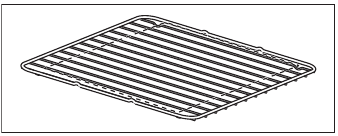
The grilling area is set in centre of the shelf.
Dual Grill - Top Oven
![]()
| Food | Time (min) | Shelf position |
| Bacon Rashers | 5 - 6 | 3 |
| Chicken Joints | 20 - 40 | 2 |
| Chops - Lamb | 15 - 25 | 2 - 3 |
| Chops - Pork | 20 - 25 | 2 - 3 |
| Fish - Whole / Trout / Makarel | 10 - 12 | 2 |
| Fillets - Plaice / Cod | 4 - 6 | 2 |
| Kebabs | 12 - 18 | 2 - 3 |
| Kidneys - Lamb / Pig | 6 - 10 | 2 - 3 |
| Sausages | 20 - 30 | 3 |
| Steaks: Rare | 4 - 6 | 3 |
| Steaks: Medium | 6 - 8 | 3 |
| Steaks: Well Done | 12 - 15 | 3 |
Defrost
![]()
- Remove the food packaging. Put the food on a plate.
- Do not cover it with a bowl or a plate. This can extend the defrost time.
- Use the first shelf position. The one on the bottom.
Information for test institutes
Main oven
| Food | Function | Temperature (°C) | Time (min) | Accessories | Shelf position |
| Small cakes (20 small cakes per tray) | Conventional Cooking | 170 | 25 - 35 | Tray | 3 |
| Small cakes (20 small cakes per tray) | Thermaflow® | 150 | 25 - 35 | Tray | 3 |
| Small cakes (20 small cakes per tray) | Thermaflow® | 150 | 25 - 35 | Tray | 1 / 4 |
| Apple pie, 2 tins (ø 20 cm) on the grid, diagonally shifted | Conventional Cooking | 200 | 80 - 100 | Grid | 1 |
| Apple pie, 2 tins (ø 20 cm) on the grid, diagonally shifted | Thermaflow® | 170 | 80 - 100 | Grid | 2 |
| Apple pie, 2 tins (ø 20 cm) on the grid, diagonally shifted 1) | Steam Bake | 160 | 70 - 80 | Tray | 2 |
| Fatless sponge cake, 1 tin (ø 26 cm) on the grid | Conventional Cooking | 200 | 25 - 35 | Grid | 2 |
| Fatless sponge cake, 1 tin (ø 26 cm) on the grid | Thermaflow® | 170 | 25 - 35 | Grid | 2 |
| Fatless sponge cake, 1 tin (ø 26 cm) on the grid | Thermaflow® | 170 | 30 - 40 | Grid | 1 / 4 |
| Shortbread/Pastry strip | Conventional Cooking | 160 | 20 - 30 | Tray | 3 |
| Shortbread/Pastry strip | Thermaflow® | 140 | 20 - 30 | Tray | 3 |
| Shortbread/Pastry strip | Thermaflow® | 140 | 15 - 25 | Tray | 1 / 4 |
1) Add 150 ml of water to the cavity embossment.
Top oven
| Food | Function | Temperature (°C) | Time (min) | Accessories | Shelf position |
| Small cakes (20 small cakes per tray) | Conventional Cooking | 150 | 25 - 35 | Tray | 2 |
| Apple pie, 2 tins (ø 20 cm) on the grid, diagonally shifted | Conventional Cooking | 170 | 60 - 80 | Grid | 1 |
| Fatless sponge cake, 1 tin (ø 26 cm) on the grid | Conventional Cooking | 170 | 20 - 30 | Grid | 2 |
| Shortbread/Pastry strip | Conventional Cooking | 140 | 15 - 25 | Tray | 2 |
| Toast | Full Grill | - | 3 - 8 | Grid | 2 |
| Beef burger | Dual Circuit Grill | - | 15 - 25 (first side) 10 - 20 (second side) | Grid / Roasting pan | 2 |
OVEN - CARE AND CLEANING
Refer to Safety chapters.
Notes on cleaning
 Cleaning Agents | Clean the front of the appliance only with a microfibre cloth with warm water and a mild detergent. |
| Use a cleaning solution to clean metal surfaces. | |
| Clean stains with a mild detergent. Do not apply it on the catalytic surfaces. | |
 Everyday Use | Clean the cavity after each use. Fat accumulation or other residue may cause fire. |
| Do not store the food in the appliance for longer than 20 minutes. Dry the cavity only with a microfibre cloth after each use. | |
 Accessories | Clean all accessories after each use and let them dry. Use only a microfibre cloth with warm water and a mild detergent. Do not clean the accessories in a dishwasher. |
| Do not clean the non-stick accessories using abrasive cleaner or sharp-edged objects. |
Catalytic cleaning
Do not clean the catalytic surface with oven sprays, soap or other cleaning agents. It will damage the catalytic surface.

Always turn the oven light on while using the catalytic cleaning (if applicable).
Keep children away when you clean the oven at a high temperature. The oven surface becomes very hot and there is a risk of burns.


The walls with catalytic coating are selfcleaning. They absorb fat which collects on the walls while the appliance operates.
To support the self-cleaning procedure, heat the empty oven on a regular basis.
The oven cavities must be cleaned separately.
Cleaning the top oven
- Clean the oven floor with warm water and washing-up liquid, then dry it.
- Set the oven temperature to 250°C and let the oven operate for 1 hour.
- When the appliance is cool, clean it with a soft and moist sponge.
Cleaning the main oven
- Clean the oven floor with warm water and washing-up liquid, then dry it.
- Set the oven temperature to 250°C and let the oven operate for 1 hour.
- When the appliance is cool, clean it with a soft and moist sponge.
Removing the shelf supports
To clean the oven, remove the shelf supports.
- Pull the front of the shelf support away from the side wall.
![Zanussi - ZCI66280WA - Removing the shelf supports - Step 1 Removing the shelf supports - Step 1]()
- Pull the rear end of the shelf support away from the side wall and remove it.
![Zanussi - ZCI66280WA - Removing the shelf supports - Step 2 Removing the shelf supports - Step 2]()
Install the shelf supports in the opposite sequence.
Make sure that the longer fixing wire is in the front. The ends of the two wires must point to the rear. Incorrect installation can cause damage to the enamel.
Removing and cleaning the door glasses - top oven

- Open the door.
- Hold the door trim on the top edge of the door at the two sides and push inwards to release the clip seal.
![Zanussi - ZCI66280WA - Removing and cleaning the door glasses - top oven Removing and cleaning the door glasses - top oven]()
- Pull the door trim to the front to remove it.
- Remove the glass panels.
To install the panels, do the same steps in reverse.
Removing and cleaning the door glasses - main oven

- Push the door trim at one side to remove it.
![Zanussi - ZCI66280WA - Removing and cleaning the door glasses - main oven Removing and cleaning the door glasses - main oven]()
- Pull up the trim.
- Remove the glass panels.

Refer to the image.
Replacing the lamp
Risk of electric shock.
The lamp can be hot.
- Turn off the oven. Wait until the oven is cold.
- Disconnect the oven from the mains.
- Put a cloth on the bottom of the cavity.
The back lamp

- Turn the lamp glass cover counterclockwise to remove it.
- Clean the glass cover.
- Replace the oven lamp with a suitable 300°C heat-resistant oven lamp. Use the same oven lamp type.
- Install the glass cover.
TROUBLESHOOTING
Refer to Safety chapters.
What to do if...
| Problem | Possible cause | Remedy |
| You cannot activate the appliance. | The appliance is not connected to an electrical supply or it is connected incorrectly. | Check if the appliance is correctly connected to the electrical supply. |
| You cannot activate the appliance. | The fuse is blown. | Make sure that the fuse is the cause of the malfunction. If the fuse is blown again and again, contact a qualified electrician. |
| You cannot activate or operate the hob. | You touched 2 or more sensor fields at the same time. | Touch only one sensor field. |
| You cannot activate or operate the hob. | There is water or fat stains on the control panel | Clean the control panel. |
| An acoustic signal sounds and the hob deactivates. An acoustic signal sounds when the hob is deactivated. | You put something on one or more sensor fields. | Remove the object from the sensor fields. |
| Residual heat indicator does not come on. | The zone is not hot because it operated only for a short time. | If the zone operated sufficiently long to be hot, speak to an Authorised Service Centre. |
| Automatic Heat Up function does not operate. | The zone is hot. | Let the zone become sufficiently cool. |
| Automatic Heat Up function does not operate. | The highest heat setting is set. | The highest heat setting has the same power as the function. |
| The sensor fields become hot. | The cookware is too large or you put it too near to the controls. | Put large cookware on the rear zones if possible. |
| There is no signal when you touch the panel sensor fields. | The signals are deactivated. Automatic Switch Off operates. | Activate the signals. Refer to "Hob - Daily use" chapter. Deactivate the hob and activate it |
 comes on the hob display. comes on the hob display. | Automatic Switch Off operates. The Child Safety Device or the Lock | Deactivate the hob and activate it again. Refer to "Hob - Daily use" chapter. |
 comes on the hob display. comes on the hob display. | The Child Safety Device or the Lock function operates. | Refer to "Hob - Daily use" chapter. |
 comes on the hob display. comes on the hob display. | There is no cookware on the zone. | Put cookware on the zone. |
 comes on the hob display. comes on the hob display. | The cookware is incorrect. The diameter of the bottom of the | Use the correct cookware. Refer to "Hob - Hints and tips" chapter. Use cookware with correct dimensions. |
 comes on the hob display. comes on the hob display. | The diameter of the bottom of the cookware is too small for the zone. | Use cookware with correct dimensions. Refer to "Hob - Hints and tips" chapter. |
| The oven does not heat up. | The oven is deactivated. | Activate the oven. |
| The oven does not heat up. | The clock is not set. | Set the clock. |
| The oven does not heat up. | The necessary settings are not set. | Make sure that the settings are correct. |
| The lamp does not operate. | The lamp is defective. | Replace the lamp. |
| The display shows "12.00". | There was a power cut. | Reset the clock. |
| Steam and condensation settle on the food and in the cavity of the oven. | You left the dish in the oven for too long. | Do not leave the dishes in the oven for longer than 15 - 20 minutes after the cooking process ends. |
Service data
If you cannot find a solution to the problem yourself, contact your dealer or an Authorised Service Centre.
The necessary data for the service centre is on the rating plate. The rating plate is on the front frame of the appliance cavity. Do not remove the rating plate from the appliance cavity.
We recommend that you write the data here:
Model (MOD.)
Product number (PNC)
Serial number (S.N.)
ENERGY EFFICIENCY
Product Information according to EU and UK Ecodesign Regulations for hob
| Model identification | ZCI66280WA ZCI66280BA ZCI66280XA | |
| Type of hob | Hob inside Freestanding Cooker | |
| Number of cooking zones | 4 | |
| Heating technology | Induction | |
| Diameter of circular cooking zones (Ø) | Left front Left rear Right front Right rear | 21.0 cm 14.0 cm 18.0 cm 18.0 cm |
| Energy consumption per cooking zone (EC electric cooking) | Left front Left rear Right front Right rear | 178.0 Wh/kg 179.0 Wh/kg 181.0 Wh/kg 181.0 Wh/kg |
| Energy consumption of the hob (EC electric hob) | 179.8 Wh/kg | |
IEC/EN 60350-2 - Household electric cooking appliances - Part 2: Hobs - Methods for measuring performance.
Hob - Energy saving
You can save energy during everyday cooking if you follow the hints below.
- When you heat up water, use only the amount you need.
- If it is possible, always put the lids on the cookware.
- Put the cookware directly in the centre of the cooking zone.
- Use the residual heat to keep the food warm or to melt it.
Product Information and Product Information Sheet according to EU and UK Ecodesign and Energy Labelling Regulations for ovens
| Supplier's name | Zanussi | |
| Model identification | ZCI66280WA 948904309 ZCI66280BA 989904310 ZCI66280XA 948904311 | |
| Energy Efficiency Index | Top oven: 105.6 Main oven: 95.4 | |
| Energy efficiency class | Top oven: A Main oven: A | |
| Energy consumption with a standard load, conventional mode | Top oven: 0.75 Main oven: not applicable | |
| Energy consumption with a standard load, fan-forced mode | Top oven: not applicable Main oven: 0.83 kWh/cycle | |
| Number of cavities | 2 | |
| Heat source | Electricity | |
| Volume | Top oven: 39 l Main oven: 77 l | |
| Type of oven | Oven inside Freestanding Cooker | |
| Mass | ZCI66280WA | 61.7 kg |
| ZCI66280BA | 61.5 kg | |
| ZCI66280XA | 61.5 kg | |
IEC/EN 60350-1 - Household electric cooking appliances - Part 1: Ranges, ovens, steam ovens and grills - Methods for measuring performance.
Oven - Energy saving
![]()
The appliance has features which help you save energy during everyday cooking.
Make sure that the appliance door is closed when the appliance operates. Do not open the appliance door too often during cooking. Keep the door gasket clean and make sure it is well fixed in its position.
Use metal cookware to improve energy saving.
When possible, do not preheat the appliance before cooking.
Keep breaks between baking as short as possible when you prepare a few dishes at one time.
Cooking with fan
When possible, use the cooking functions with fan to save energy.
Residual heat
When the cooking duration is longer than 30 min, reduce the appliance temperature to minimum 3 - 10 min before the end of cooking. The residual heat inside the appliance will continue to cook.
Use the residual heat to warm up other dishes.
Keep food warm
Choose the lowest possible temperature setting to use residual heat and keep a meal warm.
SAFETY INFORMATION

Children and vulnerable people safety
- This appliance can be used by children aged from 8 years and above and persons with reduced physical, sensory or mental capabilities or lack of experience and knowledge if they have been given supervision or instruction concerning the use of the appliance in a safe way and understand the hazards involved. Children of less than 8 years of age and persons with very extensive and complex disabilities shall be kept away from the appliance unless continuously supervised.
- Children should be supervised to ensure that they do not play with the appliance.
- Keep all packaging away from children and dispose of it appropriately.
The appliance and its accessible parts become hot during use. Keep children and pets away from the appliance when in use and when cooling down.- If the appliance has a child safety device, it should be activated.
- Children shall not carry out cleaning and user maintenance of the appliance without supervision.
General Safety
- This appliance is for cooking purposes only.
- This appliance is designed for single household domestic use in an indoor environment.
- This appliance may be used in, offices, hotel guest rooms, bed & breakfast guest rooms, farm guest houses and other similar accommodation where such use does not exceed (average) domestic usage levels.
- Only a qualified person must install this appliance and replace the cable.
- This appliance must be connected to the mains with aH05VV-F type cable to withstand the temperature of the rear panel.
- This appliance is intended for use up to an altitude of 2000m above sea level.
- This appliance is not intended to be used on ships, boats or vessels.
- Do not install the appliance behind a decorative door in order to avoid overheating.
- Do not install the appliance on a platform.
- Do not operate the appliance by means of an external timer or separate remote-control system.
Unattended cooking on a hob with fat or oil can be dangerous and may result in fire.- Never use water to extinguish the cooking fire. Switch off the appliance and cover flames with e.g. a fire blanket or lid.
The cooking process has to be supervised. A short term cooking process has to be supervised continuously.
Danger of fire: Do not store items on the cooking surfaces.- Do not use a steam cleaner to clean the appliance.
- Do not use harsh abrasive cleaners or sharp metal scrapers to clean the glass door or the glass of hinged lids of the hob since they can scratch the surface, which may result in shattering of the glass.
- Metallic objects such as knives, forks, spoons and lids should not be placed on the hob surface since they can get hot.
- If the glass ceramic surface / glass surface is cracked, switch off the appliance and unplug it from the mains. In case the appliance is connected to the mains directly using junction box, remove the fuse to disconnect the appliance from power supply. In either case contact the Authorised Service Centre.
- After use, switch off the hob element by its control and d onot rely on the pan detector.
The appliance and its accessible parts become hot during use. Care should be taken to avoid touching heating elements.- Always use oven gloves to remove or insert accessories or ovenware.
- Before maintenance, cut the power supply.
Ensure that the appliance is switched off before replacing the lamp to avoid the possibility of electric shock.- If the mains power supply cable is damaged, it must be replaced by the manufacturer, its Authorised Service Centre or similarly qualified persons to avoid an electrical hazard.
- To remove the shelf supports first pull the front of the shelf support and then the rear end away from the side walls. Install the shelf supports in the opposite sequence.
- The means for disconnection must be incorporated in the fixed wiring in accordance with the wiring rules.
Use only hob guards designed by the manufacturer of the cooking appliance or indicated by the manufacturer of the appliance in the instructions for use as suitable or hob guards incorporated in the appliance. The use of inappropriate guards can cause accidents.
SAFETY INSTRUCTIONS
Installation
Only a qualified person must install this appliance.
- Remove all the packaging.
- Do not install or use a damaged appliance.
- Follow the installation instructions supplied with the appliance.
- Always take care when moving the appliance as it is heavy. Always use safety gloves and enclosed footwear.
- Do not pull the appliance by the handle.
- The kitchen cabinet and the recess must have suitable dimensions.
- Keep the minimum distance from other appliances and units.
- Install the appliance in a safe and suitable place that meets installation requirements.
- Parts of the appliance carry current. Close the appliance with furniture to prevent touching the dangerous parts.
- The sides of the appliance must stay next to appliances or units with the same height.
- Do not install the appliance adjacent to a door or under a window. This prevents hot cookware to fall from the appliance when the door or the window is opened.
- Make sure to install a stabilizing means in order to prevent tipping of the appliance.
Refer to Installation chapter.
Electrical Connection
Risk of fire and electric shock.
- All electrical connections should be made by a qualified electrician.
- The appliance must be earthed.
- Make sure that the parameters on the rating plate are compatible with the electrical ratings of the mains power supply.
- Always use a correctly installed shockproof socket.
- Do not use multi-plug adapters and extension cables.
- Do not let mains cables touch or come near the appliance door or the niche below the appliance, especially when it operates or the door is hot.
- The shock protection of live and insulated parts must be fastened in such a way that it cannot be removed without tools.
- Connect the mains plug to the mains socket only at the end of the installation. Make sure that there is access to the mains plug after the installation.
- If the mains socket is loose, do not connect the mains plug.
- Do not pull the mains cable to disconnect the appliance. Always pull the mains plug.
- Use only correct isolation devices: line protecting cut-outs, fuses (screw type fuses removed from the holder), earth leakage trips and contactors.
- The electrical installation must have an isolation device which lets you disconnect the appliance from the mains at all poles. The isolation device must have a contact opening width of minimum 3 mm.
- Fully close the appliance door before you connect the mains plug to the mains socket.
Use
Risk of injury and burns.
Risk of electrical shock.
- Do not change the specification of this appliance.
- Make sure that the ventilation openings are not blocked.
- Do not let the appliance stay unattended during operation.
- Deactivate the appliance after each use.
- Be careful when you open the appliance door while the appliance is in operation. Hot air can release.
- Do not operate the appliance with wet hands or when it has contact with water.
- Do not use the appliance as a work surface or as a storage surface.
- Users with a pacemaker must keep a distance of minimum 30 cm from the induction cooking zones when the appliance is in operation.
- Do not use aluminum foil or other materials between the cooking surface and the cookware, unless otherwise specified by the manufacturer of this appliance.
- Use only accessories recommended for this appliance by the manufacturer.
Risk of fire and explosion.
- Fats and oil when heated can release flammable vapours. Keep flames or heated objects away from fats and oils when you cook with them.
- The vapours that very hot oil releases can cause spontaneous combustion.
- Used oil, that can contain food remnants, can cause fire at a lower temperature than oil used for the first time.
- Do not put flammable products or items that are wet with flammable products in, near or on the appliance.
- Do not let sparks or open flames to come in contact with the appliance when you open the door.
- Open the appliance door carefully. The use of ingredients with alcohol can cause a mixture of alcohol and air.
Risk of damage to the appliance.
- To prevent damage or discoloration to the enamel:
- do not put ovenware or other objects in the appliance directly on the bottom.
- do not put aluminium foil directly on the bottom of cavity.
- do not put water directly into the hot appliance.
- do not keep moist dishes and food in the appliance after you finish the cooking.
- be careful when you remove or install the accessories.
- Discoloration of the enamel or stainless steel has no effect on the performance of the appliance.
- Use a deep pan for moist cakes. Fruit juices cause stains that can be permanent.
- Do not keep hot cookware on the control panel.
- Do not let cookware boil dry.
- Be careful not to let objects or cookware fall on the appliance. The surface can be damaged.
- Do not activate the cooking zones with empty cookware or without cookware.
- Cookware made of cast iron, aluminium or with a damaged bottom can cause scratches. Always lift these objects up when you have to move them on the cooking surface.
Care and Cleaning
Risk of injury, fire, or damage to the appliance.
- Before maintenance, deactivate the appliance. Disconnect the mains plug from the mains socket.
- Make sure the appliance is cold. There is the risk that the glass panels can break.
- Replace immediately the door glass panels when they are damaged. Contact the Authorised Service Centre.
- Be careful when you remove the door from the appliance. The door is heavy!
- Fat and food remaining in the appliance can cause fire.
- Clean regularly the appliance to prevent the deterioration of the surface material.
- Make sure the cavity and the door are wiped dry after each use. Steam produced during the operation of the appliance condensates on cavity walls and can cause corrosion. To decrease the condensation operate the appliance for 10 minutes before cooking.
- Clean the appliance with a moist soft cloth. Use only neutral detergents. Do not use abrasive products, abrasive cleaning pads, solvents or metal objects.
- If you use an oven spray, follow the safety instructions on the packaging.
- Do not clean the catalytic enamel (if applicable) with any kind of detergent.
Internal lighting
Risk of electric shock.
- Concerning the lamp(s) inside this product and spare part lamps sold separately:
These lamps are intended to withstand extreme physical conditions in household appliances, such as temperature, vibration, humidity, or are intended to signal information about the operational status of the appliance. They are not intended to be used in other applications and are not suitable for household room illumination. - This product contains a light source of energy efficiency class G.
- Use only lamps with the same specifications.
Service
- To repair the appliance contact the Authorised Service Centre.
- Use original spare parts only.
VISIT OUR WEBSITE TO:
Get usage advice, brochures, trouble shooter, service and repair information: www.zanussi.com/support

Documents / Resources
References
Download manual
Here you can download full pdf version of manual, it may contain additional safety instructions, warranty information, FCC rules, etc.
Download Zanussi ZCI66280WA, ZCI66280BA, ZCI66280XA - Electric Cooker Manual
Advertisement
Thank you! Your question has been received!
 comes on and the cooking zone deactivates automatically after 2 minutes.
comes on and the cooking zone deactivates automatically after 2 minutes. until you hear a beep and keep it pressed until you hear the second beep.
until you hear a beep and keep it pressed until you hear the second beep. for 3 seconds until
for 3 seconds until  or
or  comes on.
comes on. of the Timer to select the desired mode (H0 - H6). The chosen mode activates automatically after 10 seconds.
of the Timer to select the desired mode (H0 - H6). The chosen mode activates automatically after 10 seconds.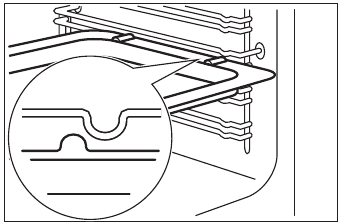


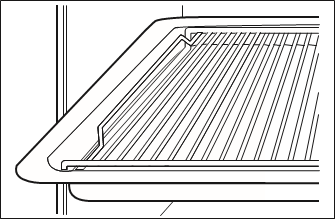
 again and again until
again and again until  starts to flash.
starts to flash. or
or  to set the necessary time.
to set the necessary time.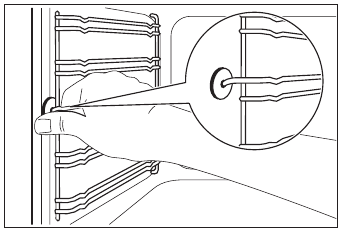
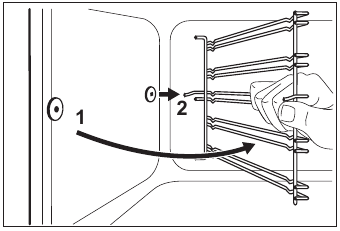
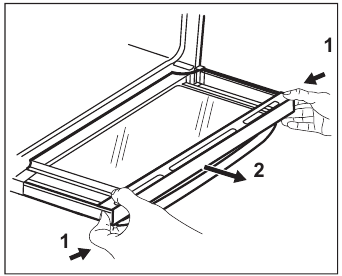













Need Assistance?
Do you have a question about the ZCI66280WA that isn't answered in the manual? Leave your question here.